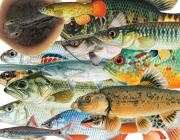We are pleased to see the Fishes of Texas (FoTX) Project database and our analyses of its content now transformed into an innovative new, and broadly collaborative, on-the-ground Texas Parks and Wildlife Department conservation action program, complete with its very own independent web pages (https://nativefishconservation.org/).
Overview: Approximately 47% of Texas native freshwater fishes are considered imperiled. The primary cause is anthropogenic alteration of freshwater systems, which continues to occur at rates and scales that threaten the long-term resiliency of freshwater habitats, species, and ecosystems. An integrated, holistic, multi-species, and habitat-based approach to conservation of freshwater systems was necessary to address these issues. So, Texas Parks and Wildlife Department and the Fishes of Texas Project collaborated on Watershed-Based Conservation Planning that utilized our Species Distribution Models (SDMs) to create a statewide network of Native Fish Conservation Areas (NFCAs).
Management Implementation: Twenty NFCAs have now been designated statewide, each selected on the basis of FoTX’s spatial prioritization focused on identifying areas critically important to the long-term persistence of 90 freshwater fish species of greatest conservation need. Each NFCA now has its own group of stakeholders who meet to collaboratively prioritize NFCA-wide conservation action projects to benefit native fish communities. This approach encourages and facilitates coordination among land owners, non-governmental organizations, state and federal agencies, universities, and local governments to achieve landscape-scale conservation within focal watersheds.
History: This effort evolved from an initial Great Plains Landscape Conservation Cooperative (GPLCC) grant to FoTX that yielded the identification of priority conservation actions and research needs for focal fish species and priority watersheds of the GPLCC. Background on this project can be found here.

